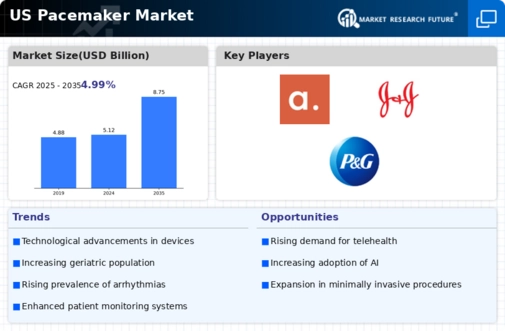Growing Geriatric Population
The aging population in the US is a significant factor influencing the pacemaker market. As individuals age, the risk of developing heart-related issues increases, leading to a higher demand for cardiac devices. By 2030, it is estimated that 20% of the US population will be over 65 years old, creating a substantial market for pacemakers. This demographic shift necessitates the development of tailored healthcare solutions to address the unique needs of older patients. Consequently, the pacemaker market is expected to expand, with a projected increase in sales driven by the rising number of elderly individuals requiring cardiac interventions. This trend highlights the critical intersection of demographic changes and healthcare needs.
Increased Awareness and Education
There is a growing awareness regarding heart health and the role of pacemakers in managing cardiac conditions. Educational campaigns by healthcare organizations and advocacy groups are informing the public about the symptoms of heart disease and the benefits of pacemaker implantation. This heightened awareness is likely to lead to earlier diagnosis and treatment, thereby increasing the demand for pacemakers. The pacemaker market is benefiting from this trend, as more patients seek medical advice and intervention. Furthermore, healthcare providers are increasingly recommending pacemakers as a viable treatment option, contributing to a projected market growth of 5% annually over the next five years. This trend underscores the importance of patient education in driving market expansion.
Rising Incidence of Cardiac Diseases
The increasing prevalence of cardiac diseases in the US is a primary driver for the pacemaker market. According to recent statistics, cardiovascular diseases account for nearly 697,000 deaths annually, representing about 1 in every 5 deaths. This alarming trend necessitates advanced medical interventions, including pacemakers, to manage arrhythmias and other heart conditions. As healthcare providers seek effective solutions, the demand for pacemakers is expected to rise significantly. The pacemaker market is projected to grow at a CAGR of approximately 6.5% over the next few years, driven by the urgent need for innovative cardiac care solutions. This growth reflects a broader trend in the healthcare sector, where the focus is increasingly on improving patient outcomes through advanced technology.
Regulatory Support for Medical Devices
Regulatory frameworks in the US are evolving to support the development and approval of innovative medical devices, including pacemakers. The FDA has implemented streamlined processes for the review of new technologies, which encourages manufacturers to invest in research and development. This regulatory support is crucial for fostering innovation within the pacemaker market. As a result, companies are more likely to introduce advanced devices that meet the needs of patients and healthcare providers. The anticipated growth in the market is further bolstered by favorable reimbursement policies that facilitate patient access to these life-saving devices. Overall, the regulatory environment is expected to play a pivotal role in shaping the future of the pacemaker market.
Technological Innovations in Device Design
Innovations in pacemaker technology are transforming the pacemaker market. Recent advancements include leadless pacemakers and MRI-compatible devices, which enhance patient comfort and safety. These innovations not only improve the functionality of pacemakers but also expand their applicability to a wider range of patients. The introduction of remote monitoring capabilities allows healthcare providers to track patient data in real-time, leading to better management of cardiac conditions. As a result, the market is witnessing a shift towards more sophisticated devices that cater to the evolving needs of patients. The estimated market value for these advanced devices is expected to reach $5 billion by 2027, indicating a robust growth trajectory fueled by technological progress.

















Leave a Comment